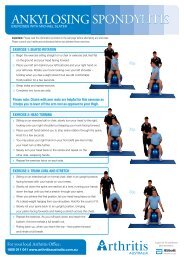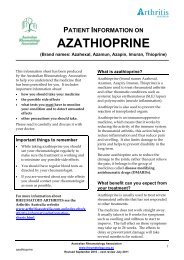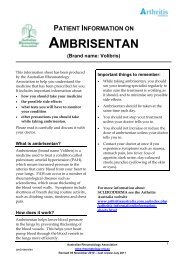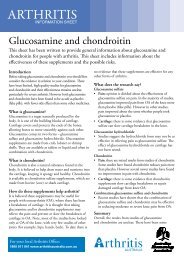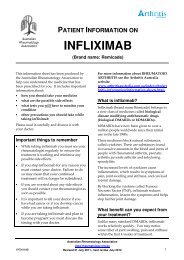HYALURONIC ACID
HYALURONIC ACID
HYALURONIC ACID
- No tags were found...
You also want an ePaper? Increase the reach of your titles
YUMPU automatically turns print PDFs into web optimized ePapers that Google loves.
AustralianRheumatologyAssociationPATIENT INFORMATION ON<strong>HYALURONIC</strong> <strong>ACID</strong>(also known as hyaluronan, sodium hyaluronate, hylan GF20)(Examples of brand names: Synvisc, Orthoartz)This information sheet has been producedby the Australian Rheumatology Associationto help you understand the medicine thathas been prescribed for you. It includesimportant information about:• how you should take your medicine• what are the possible side effects• what tests you should have to monitoryour condition and to detect unwantedeffects• other precautions you should take.Please read it carefully and discuss withyour doctor.Important things to remember:• You should tell your doctor if pain andswelling in the joint increases followingthe injection.• You should tell your doctor if your jointbecomes red and hot following theinjection.What is hyaluronic acid?Hyaluronic acid (brand names Synvisc,Orthoartz) is used to treat osteoarthritis, acondition that affects the joints. It is mostcommonly used to treat osteoarthritis of theknee.In a normal joint, a layer of cartilage orgristle covers the ends of the bones.Cartilage helps the joint move smoothly andcushions the ends of the bones. Inosteoarthritis, cartilage breaks down andbecomes thin. This leaves the ends of thebones unprotected and the joint loses itsability to move smoothly.Hyaluronic acid is found naturally in jointsand other parts of the body. In the joint, it isfound in the cartilage and the synovial fluidthat lubricate the joints to keep themworking smoothly.In people with osteoarthritis, the hyaluronicacid gets thinner and it is no longer able toprotect the joint. Injections of artificialhyaluronic acid into affected joints canimprove the protection.Hyaluronic acid injections are usuallyoffered to people with osteoarthritis of theknee if other treatments have not worked.For more information aboutOSTEOARTHRITIS see the ArthritisAustralia websitewww.arthritisaustralia.com.au/index.php/arthritis-information/informationsheets.html.What benefit can you expect fromyour treatment?Hyaluronic acid injections help reduce thepain caused by osteoarthritis. Some patientsfind relief from symptoms within a fewdays. Full benefits usually are reached 3-5weeks after the treatment.Australian Rheumatology Associationhttp://www.rheumatology.org.auhyaluronic acidRevised 23 August 2011– next review July 20121
The treatment may provide pain relief for upto 6 months. Response varies and theinjections do not help everyone. Ifsuccessful, the injections can be repeatedafter 6 months.How is hyaluronic acid given?Your doctor will inject the hyaluronic aciddirectly into the knee joint. Local anaestheticis sometimes used before the injection.Injections may be given once a week forthree weeks or a single injection, dependingon the particular product your doctorrecommends.Can other medicines be taken withhyaluronic acid?Hyaluronic acid may be used with otherarthritis medicines including:• steroid medicines such as cortisoneinjections into the joint• anti-inflammatory medicines (NSAIDs)such as naproxen (Naprosyn) oribuprofen (Brufen, Nurofen)• simple pain medicines such asparacetamol.There are separate information sheets for themedicines mentioned above.Are there any side effects?Side effects from hyaluronic acid injectionsare not common. Most are limited to the siteof injection and do not last long. Tell yourdoctor if you are concerned about possibleside effects.Most common possible side effects:Local side affects may include:• redness and tenderness at the site of theinjection• increased stiffness, swelling or warmthinflammation (flare) lasting 24 to 48hours following the injection.These local reactions may be treated byresting and applying ice to the injected area,or by simple pain relievers.Australian Rheumatology AssociationLess common or rare possible sideeffects:These include:• Allergy including rashes, hives, itching,flushing and swelling of the face, tongueor throat, chest tightness and shortnessof breath. If you experience any of thesesymptoms contact your doctor straightaway.• Less commonly, a joint may becomeseverely inflamed after injection. This maybe due to acute pseudogout arthritisfrom crystals in the joint. Very rarely, aninfection in the joint may develop afterthe injection. If the pain and swelling inthe joint that was injected increases agreat deal or the joint becomes red andhot contact your doctor quickly.• Other side effects that have been observedinclude: headache, muscle pain, nausea,sore throat and flu-like symptoms.What other precautions arenecessary?After the injection• It is recommended that strenuous activity(e.g. high impact sport such as jogging ortennis) or prolonged weight-bearingactivities are avoided for about 48 hoursafter the injection.Infection• Hyaluronic acid injections will not begiven if you have an infection in yourjoint or a skin disease or infection aroundthe area where the injection will be given.Circulation• Hyaluronic acid injections will not begiven if you have circulatory problems inyour legs.• Tell your doctor if you have significantswelling or blood clots in your legs.Allergy• Hyaluronic acid injections will not begiven if you have had a prior allergicreaction to hyaluronan-based products.http://www.rheumatology.org.auhyaluronic acidRevised 23 August 2011– next review July 20122
• Tell your doctor if you are allergic toproducts from birds such as feathers, eggsand poultry.Use with other medicines• You should tell your doctor (includingyour general practitioner, rheumatologistand others) about all medicines you aretaking or plan to take. This includes overthe counter or herbal/naturopathicmedicines.• You should also mention your treatmentwhen you see other health professionals.Use in pregnancy and breastfeeding• Hyaluronic acid has not been tested inpregnant women or women who arebreastfeeding.• It is important to tell your doctor if youare, or intend to become pregnant or ifyou are breastfeeding.Questions?If you have any questions or concerns writethem down and discuss them with yourdoctor.Your doctor’s contact detailsIf you are taking hyaluronic acid youshould see your doctor regularly to makesure the treatment is working as it shouldand to minimise any possible side effects.The information in this sheet has been obtained from various sources and has been reviewed by the Australian Rheumatology Association. It isintended as an educational aid and does not cover all possible uses, actions, precautions, side effects, or interactions of the medicinesmentioned. This information is not intended as medical advice for individual problems nor for making an individual assessment of the risks andbenefits of taking a particular medicine. It can be reproduced in its entirety but cannot be altered without permission from the ARA.The NHMRC publication: How to present the evidence for consumers: preparation of consumer publications (2000) was used as a guide indeveloping this publication.Australian Rheumatology Associationhttp://www.rheumatology.org.auhyaluronic acidRevised 23 August 2011– next review July 20123



